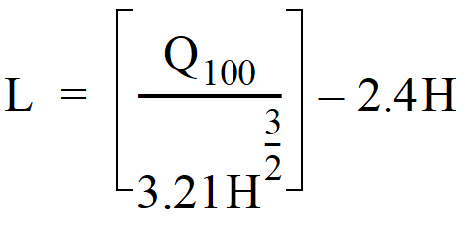21.6 A600 - Emergency Overflow Spillway
Emergency overflow spillways control the location of stormwater facility overtopping and direct overflow to the downstream conveyance system or other acceptable location.
Comply with all criteria and standards in Modeling Your Best Management Practices, Design Criteria for All Stormwater Treatment and Flow Control BMPs, Constructing Your Best Management Practices and Accessing and Maintaining Your Best Management Practices as applicable to the project in addition to criteria within each BMP. Where criteria or standards conflict, utilize the criteria and standards contained within the specific BMP.
Armor the emergency overflow spillway with riprap per A400 - Outfall Systems. Armor the full width, beginning at a point midway across the berm embankment and extending downstream to where emergency overflows reenter the conveyance system.
Design the overflow spillway as a broad crested weir designed to pass the 100-year storm event for the developed condition and to allow a minimum of 1 foot of freeboard above the maximum design storm water surface level. A sizing spreadsheet is available at www.cityoftacoma.org/stormwatermanual, this spreadsheet uses the equation below.
Q100 = peak flow for the 100-year runoff event (ft3/s)
An Ecology approved continuous simulation model, assuming a 15-minute timestep, to obtain the 100-year return period flowrate.
A single event model to obtain the peak volumetric flowrate from the 100-year, 24-hour storm event, assuming a Type 1A distribution using the SCS (TR-20) method. The 100-year, 24-hour storm event in the City of Tacoma is 4.1"
C = discharge coefficient = 0.6
H - height of water over weir (ft)
Assuming C is 0.6 and Tan θ = 3
To find L, the equation is rearranged to use Q100 and trial versions of H set at 0.2 feet minimum.
The minimum width shall be 6 feet.
Facilities regulated as dams must size the emergency overflow spillway per the Washington State Dam Safety Requirements available at http://www.ecology.wa.gov/Water-Shorelines/Water-supply/Dams
Where an emergency overflow spillway would discharge to slopes steeper than 15%, an emergency overflow structure may be more appropriate. For facilities with berms less than 2 feet in height and located at grades less than 5%, the emergency overflow may be provided by an emergency overflow structure. Figure 4 - 73: Overflow Structure provides an example of an emergency overflow structure.
The emergency overflow structure must be sized to pass the 100-year developed peak volumetric flowrate calculated using a 10-minute timestep from a Type 1A, 100-year, 24-hour frequency storm using a single event model (SCS - TR20) or the 100-year return period flowrate as estimated using an Ecology-approved continuous simulation model, assuming a 15-minute timestep with a minimum 6" of freeboard.
Figure 4 - 73: Overflow Structure



